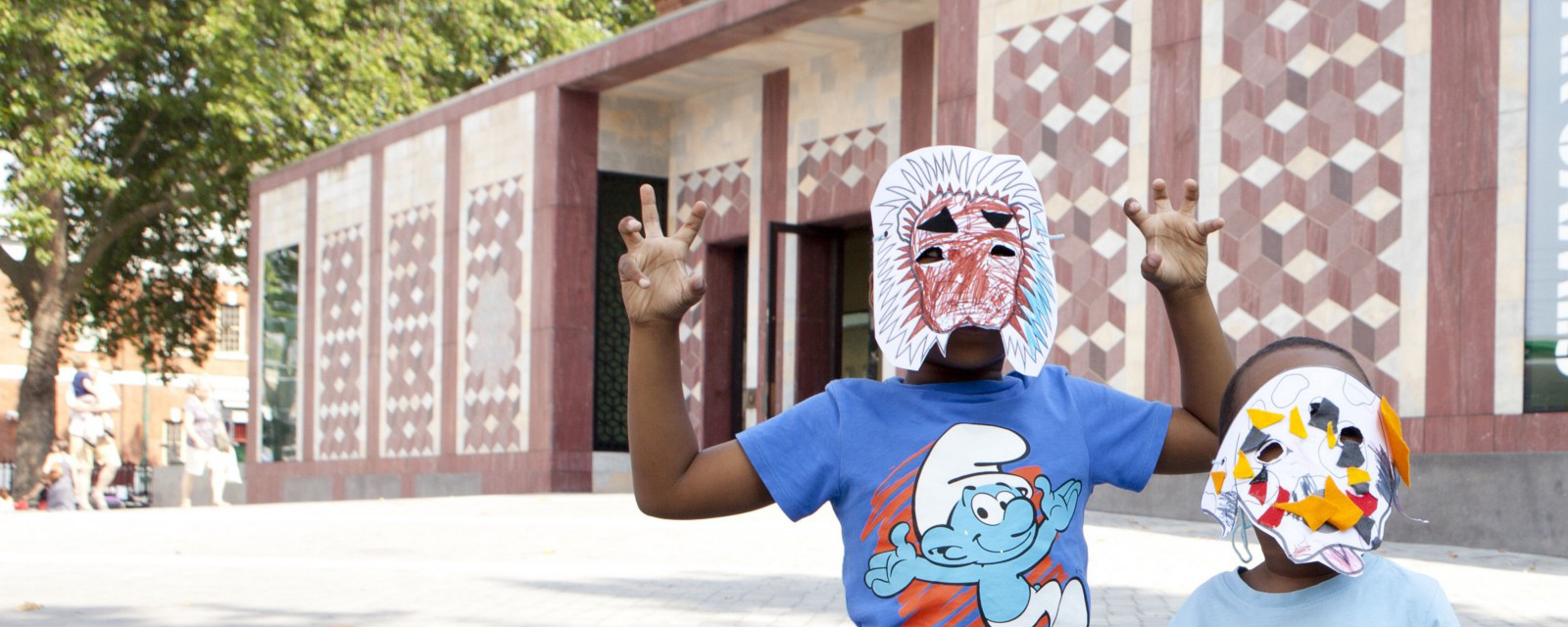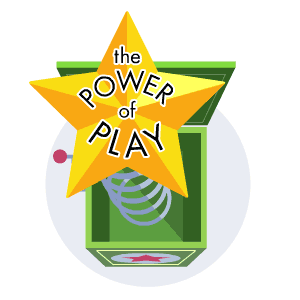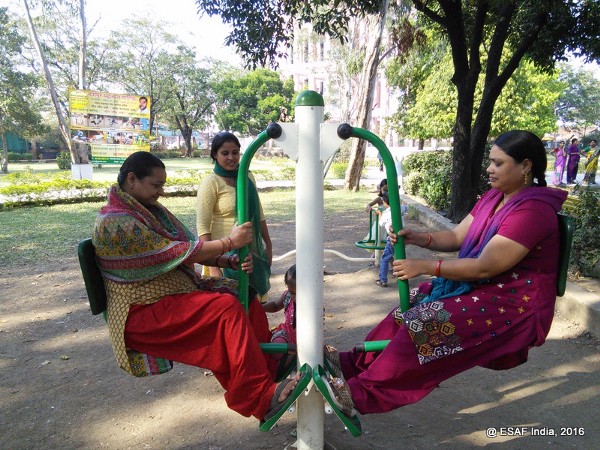

Picture a young girl in Kampala, Uganda, from a family without a lot of money. Sometimes she plays in an alleyway, other times in a vacant lot. She has to be careful in these places: A car could come careening around the corner at any moment, a stray animal could attack her, or an open drain could lead to disease. But she has to use these informal playgrounds, because there isn’t anywhere else to go.
This girl is in Kampala, but she could just as easily be in Chicago. Across the United States, poorer areas and areas with high proportions of ethnic minorities are likely to have fewer playgrounds and parks, especially safe ones. In fact, in almost every country around the world, there are major gaps between different groups of children in terms of who plays, how often, and in what ways. And these gaps in play translate directly to gaps in opportunity as adults.

Any way you slice it, playing is good for children. You don’t have to acknowledge play as an inherent right to see the concrete benefits it has for childhood development, which have been documented again and again. Children’s play is a builder of many things: cognitive development, family bonds, social skills, psychological resilience, healthy bodies.
These benefits apply to kids in relatively stable settings, as well as to those in traumatic situations. Play deprivation has been linked to reduced brain size in Romanian orphans and to disturbed behavior in lab animals. Even on top of these biological, social, and psychological advantages, play builds toward a person’s future. Play structures can get kids to attend school, and are linked to better exam results once there.

The connections between childhood play and adult success operate through traits like creativity, curiosity, and social intelligence. John McKendrick, who researches play and poverty at Glasgow Caledonian University, explains to me how this works: “Having a creative approach to solving problems is something that’s very important and something that many companies promote.”
In other words, being given a Lego or K’NEX set at a young age could have far-reaching effects. Parents and scientists love Lego for the spatial awareness skills it gives children–the building blocks they play with work in metaphor as building blocks for their future.

Today, more people live in cities than anywhere else on the planet. So when it comes to physical play, the built environment is hugely important. Playgrounds may be the most obvious kind of play infrastructure, but fields, parks, gardens, and other spaces also offer fantastic opportunities for outdoor recreation.
Unfortunately, play infrastructure is nonexistent in large part in many cities. So children are forced to be resourceful when it comes to finding places to play: in tanneries, junkyards, polluted rivers, and garbage dumps, to name a few examples.
As you might imagine, these toxic playgrounds have severe effects on health, which can affect children’s chances even before they’re born. In India’s largest city, Mumbai, the High Court has expressed concern about the likelihood of congenital defects due to the absence of green spaces reducing the city’s oxygen levels.
Manju George, who leads the Liveable Cities Program at an Indian NGO called the Evangelical Social Action Forum (ESAF), has been grappling with these challenges in three different Indian cities. Everywhere she goes, people complain about a lack of play space.
Some of the obstacles to granting that play space are infrastructural, but others are simply political. For instance, ESAF’s community mapping in Nagpur found that parks built near slums (before the slums grew up around them) weren’t being used.
The reason was simple: “Most of the time these parks were kept closed,” George says, because “the government felt that these should not be spoiled by the children [from the slums].” To overcome this issue, ESAF identified local women who could be trained to act as volunteer caretakers. The idea was to show the government that the parks could be kept safe for all.
ESAF also worked with the community to design spaces for disabled children in these parks, including areas with proper ramps, wheelchair access, and appropriate play equipment. For instance, slides were fitted with larger raised edges, so that kids with physical impairments felt safer using them. Swings that were once just wooden planks were replaced with more comfortable bucket and family swings.


Alongside these measures, ESAF has been challenging the Bengaluru government’s attempts to reduce the mandatory proportion of open space within the city. “Space is always a precious thing,” says George, who’s seen more and more space taken away from play areas in the last two decades.
This fight for urban space isn’t limited to low- and middle-income countries, either. Local governments in Finland chose to close down more than a third of public playgrounds in 2014, rather than spending the money needed to bring them up to safety codes.
But these kinds of safety improvements can be relatively easy to make. In Chicago, a study found that many of the safety issues facing parks there, like increasing the depth of wood chips covering playground surfaces, are easily correctable.
But as play increasingly goes indoors, outdoor infrastructure is only one piece of the puzzle.

Playtime is just as threatened as playgrounds. In a number of countries, schools in low-income urban areas have less time for recess than those in wealthy suburbs. But the link between class and reduced play time isn’t always straightforward, as is clear from the “all work, no play” culture of South Korean students.
In a paper published earlier this year, researcher Anna Beresin summarized the risks of decreasing time for play. “The dangers when play is removed include: obesity, depression, apathy, food disorders, sleep disorders, attention disorders, and lack of empathy,” she wrote. “We are literally making children ill by removing their play time.”
This disparity between more and less play-privileged children shows up not just in time and space for play, but also in different types of play. Rich and poor kids use computers in different ways, for instance, which are likely to make the playing field more uneven later on. More sophisticated spaces for play are also unequal–the best children’s museums in the United States typically charge $10″”20 a ticket.
As so much of the world is increasingly urbanized, we need to redefine safe play spaces–and recent movements toward innovative play like the maker and tinkerer movements are doing just that. While these movements aren’t immune to biases, they are safe spaces for play that some see as training the next generation of scientists (sometimes for very unplayful purposes, like military and political goals). They’re also spaces that face a problem of inclusion.

Karen Dwyer-Meadow runs San Francisco’s Tinkering School, which is part of the nonprofit Institute of Applied Tinkering. In her experience, limitations in access to play opportunities affect varying social classes differently: Affluent kids tend to be over-scheduled and academically over-burdened, leaving them little time for creative play, while less privileged kids often live far from play spaces and don’t have easy access to the kinds of resources offered through tinkering or similar organizations.
Improving inclusion is what fuels Dwyer-Meadow’s fire, though she admits that being able to help 10-year-olds build replica rockets from scratch is pretty cool, too. Key to inclusion, she believes, is bringing tinkering resources to less funded communities, when those communities are receptive. “Let’s make it as easy for children as possible,” she says.
This could involve working collaboratively with educators in under-resourced schools, as Tinkering School Partner Classrooms is doing in San Francisco. Or it could involve establishing a mobile tinkering school, as Tinkering School is considering for the future.
One major hurdle, however, is the cost. Tinkering School’s day camp costs $575 for five days, not including “before care” and “after care.” Financial assistance is available on a case-by-case business to underprivileged students, but Dwyer-Meadow says: “What we find is that people typically want to pay something. They want to be able to provide opportunities for children, and to be the person providing those opportunities.”
This suggests that those in the toughest of circumstances are either not applying, or are simply unaware that these programs even exist.

One thing revealed by the global deficit in play is the importance of public places. The wealthy can pay for private spaces and equipment, but government-level investments are necessary to fix the problem for the less privileged. Play has already been bundled into some anti-poverty programs and child health strategies.
Reversing cuts to play centers and ensuring more even distribution of resources to neighborhoods of different income levels would help to ease the play gap. Government policy can also create an enabling environment for grassroots groups to encourage free play, which McKendrick says has happened with Scotland’s Community Empowerment Act.
McKendrick is one of a number of researchers calling for a more family-friendly approach to urban planning. This could involve, for example, deciding which streets can be opened for play, and making sure that the places where kids do play are safe.
Meanwhile, outside of government, ESAF’s work in urban India shows the power of community groups to document who’s missing out on play opportunities and how communities feel these should be addressed.
Ultimately, more openness about costs and benefits of making play accessible could help people both realize the importance of play and learn low-cost ways to encourage it–so, too, could federal and corporate funds for teachers in lower-income and minority areas to bring hacking, making, and tinkering spaces into their own classrooms.
Dwyer-Meadow suggests, as others do, that the tinkering movement builds self-sufficiency, confidence, problem-solving, and resilience, and that “those are all aspects we want in leaders.” For the sake of our society’s future, then, we must promote a spirit of play that builds on these qualities–and builds them equitably.

Let’s return to that girl in Kampala (or Chicago). Perhaps a couple of spots in her neighborhood are now officially designated as parks, and some of her neighbors are responsible for keeping them safe. The cars have been moved off to a parking lot to make enough space for everyone.
She can play handball or chess, while her grandmother sits or gardens at the edge of the site. Both feel more comfortable now that there are bathrooms, and her parents are more at ease letting her hang out there. She can even sell food to the people walking through, and when things are slow she can go back to creating skits, songs, or model spaceships.
She’s happier, her neighbors get along better, and she’s able to pay attention to school. It’s not magic, but it is something.


How We Get To Next was a magazine that explored the future of science, technology, and culture from 2014 to 2019. This article is part of our The Power of Play section, which looks at how fun and leisure can change the world. Click the logo to read more.
